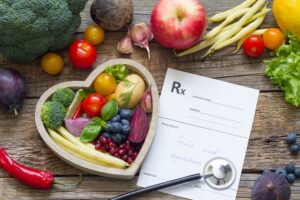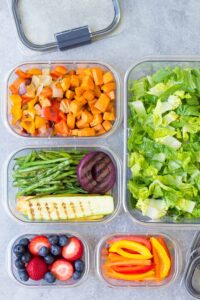Are Produce Prescriptions Better Than Drugs?
Over 2,000 years ago, Hippocrates, the father of modern medicine, said, “Let food be thy medicine.” A study published last week by the American Heart Association suggests that a diet full of fruits and vegetables can function as well as some prescription drugs—without the side effects. This research is pretty timely since we’ve recently crossed a threshold where bad diets are responsible for more deaths than smoking.
“Produce Prescriptions” are part of a growing effort in health care to provide food as medicine to prevent or improve chronic health conditions like obesity, diabetes, heart disease and high blood pressure.

In the US, only 1 in 10 adults eats enough fruits and vegetables every day. This is partially because some Americans don’t have access to or can’t afford fresh produce. It’s cheaper for Americans to buy fast food and highly processed packaged food than buying fruits and vegetables. And that’s what most low-income families choose to do, leading to 145% greater obesity rates in low-income families than middle- and high-income families.
We can thank Congress for this one. The Farm Bill that Congress renewed this year for $700 billion dollars subsidizes the overproduction of highly processed foods, making unhealthy food cheap and accessible. And don’t blame farmers. If the government promises to pay me more money to grow corn than tomatoes, I will probably grow corn. Revising the Farm Bill to incentivize fruits and vegetables would make it easier for Americans of all income levels to afford a healthy diet. But don’t count on that happening any time soon, since most of the food industry depends on cheap corn and soybeans.
Produce Prescriptions have become a short-term solution to the problem of affordable produce. The study published last month by the American Heart Association gave families from low-income neighborhoods vouchers for up to $63 a month for 4 to 10 months which could be redeemed for produce at retail stores and farmers markets. The study included nearly 4,000 people in 12 states.
The vouchers made a significant difference. Adults who participated in the programs ended up eating about 30% more fresh produce per day. But more importantly, they made significant changes to some essential aspects of their health.
High Blood Pressure
Program participants with hypertension saw an average decrease in systolic blood pressure of 8mm Hg, and diastolic blood pressure decreased by about 5 mm Hg. The average reduction of all five classes of blood pressure medications is 9.1 mm Hg systolic and 5.5 mm Hg diastolic at standard dose. This means increasing fruit consumption by 30% at a cost of $67 per month reduced blood pressure in hypertensive participants as much as the average prescription meds. That’s quite the bargain considering the average cost of 30 tablets of blood pressure meds—$329.03 per month.

Diabetes
Participants in the program with diabetes saw their A1C levels decline by about .6%. That’s about half the A1C reduction most people will experience with antidiabetic meds. The average monthly cost of those antidiabetic meds is $434 to $935.
Obesity
Program participants suffering from obesity saw a slight decline in their BMI of 0.4 kg/m2. While .04 might not sound like a lot, that’s about like losing three pounds for the average person. The authors of the study considered that amount of weight loss clinically relevant.
Health
Approximately 85% of the participants reported taking part in the program improved their health in some way. Again, the change was made with only $63 worth of produce a month per family.
Produce Prescription programs are becoming more popular throughout the country. The CDC website lists Marion County, Indiana’s, Fresh Bucks Program as a model program for other communities. As of 2020, there are 96 active produce prescription programs in the US.
But what about you and me? I’m guessing most of us reading this article don’t qualify for a produce voucher. But we can learn a lot from the program. Fruits and vegetables can be just as or even more powerful than some of our best prescription drugs. Most of us have easy access to a wealth of produce every day. How do you think you would feel if you made a deliberate effort to increase your produce consumption by 30% for the next 10 months?
Our Simple 9© nutritional program instructs our clients to eat two servings of fruit and four servings of vegetables every day. We see many of our client’s get off blood pressure and diabetes meds as a result of our workout and our nutritional advice. We highlighted two of these clients in the past few months on our Facebook page, on August 22 and February 28.
If you’re not following our Simple 9© program, ask your coach about it today.
Stay Strong and Let Food Be Thy Medicine,
Bo Railey

